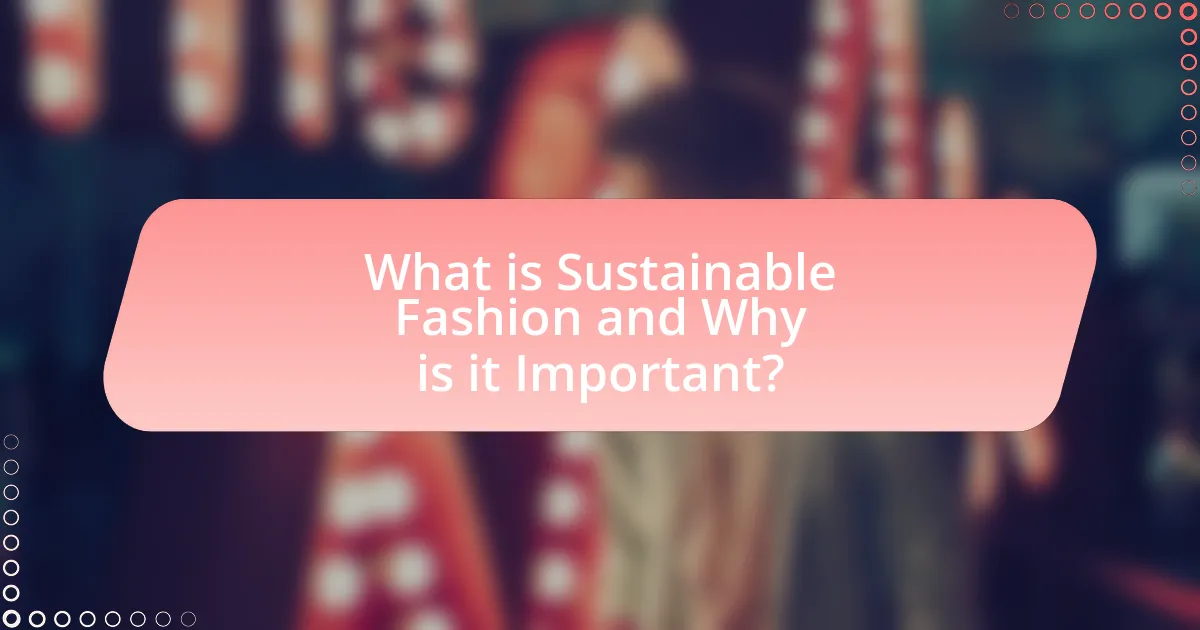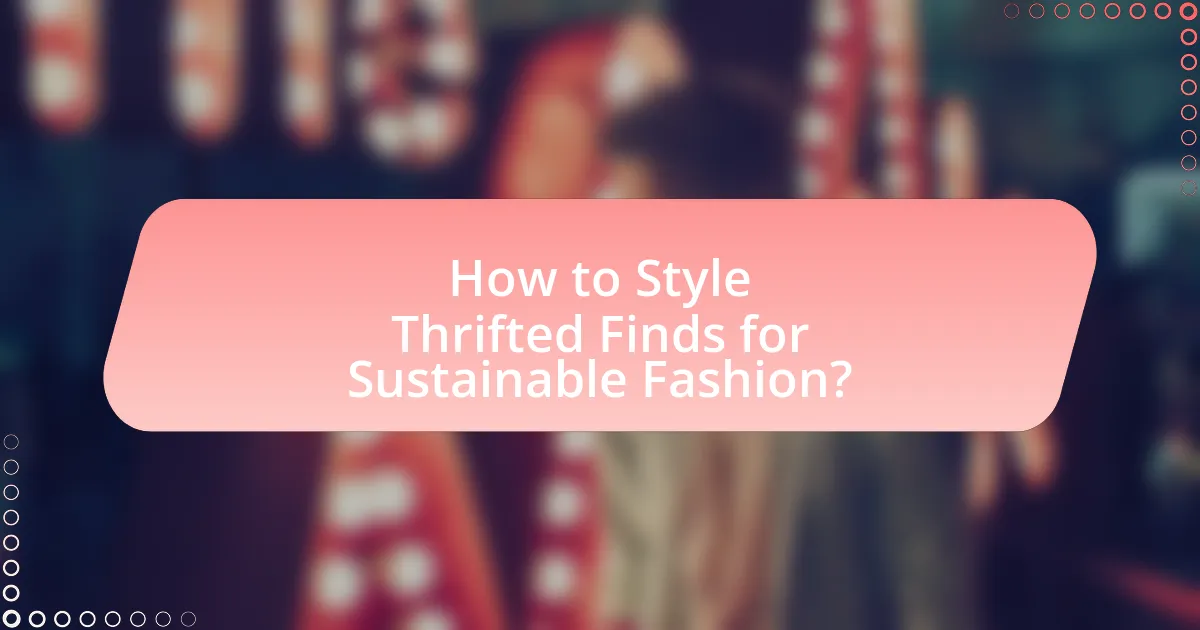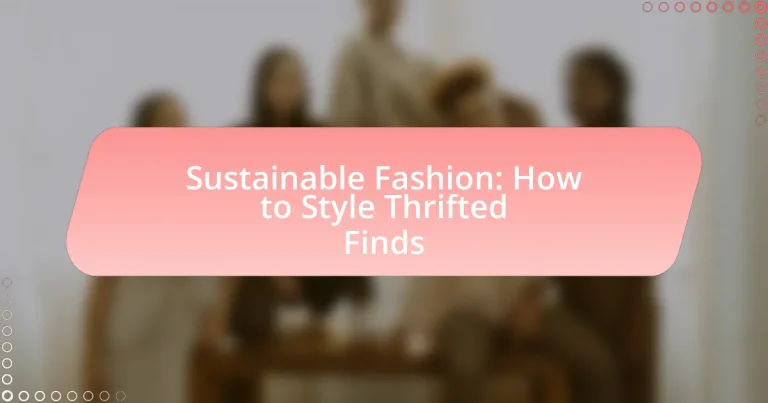Sustainable fashion emphasizes environmentally and socially responsible practices in clothing production, aiming to reduce the fashion industry’s significant environmental impact, which accounts for 10% of global carbon emissions. This article explores the differences between sustainable fashion and fast fashion, highlighting the environmental degradation caused by the latter and the benefits of eco-friendly materials and ethical labor practices. It also provides practical tips for styling thrifted clothing, including how to mix unique thrifted pieces with modern staples, accessorizing for a polished look, and overcoming common challenges associated with thrift shopping. Additionally, the article addresses misconceptions about thrifted fashion and offers strategies for successful thrift shopping, emphasizing the importance of sustainability in the fashion industry.

What is Sustainable Fashion and Why is it Important?
Sustainable fashion refers to clothing and accessories produced in environmentally and socially responsible ways, minimizing negative impacts on the planet and promoting ethical labor practices. It is important because the fashion industry is one of the largest polluters globally, contributing to significant waste and carbon emissions; for instance, the Ellen MacArthur Foundation reports that the fashion industry is responsible for 10% of global carbon emissions. Sustainable fashion aims to reduce this impact by using eco-friendly materials, promoting recycling and upcycling, and ensuring fair labor conditions, thereby fostering a more sustainable future for both the environment and society.
How does Sustainable Fashion differ from Fast Fashion?
Sustainable fashion prioritizes environmentally friendly practices and ethical labor standards, while fast fashion focuses on rapid production and low-cost garments. Sustainable fashion aims to reduce waste, utilize eco-friendly materials, and promote fair labor conditions, often resulting in higher-quality, longer-lasting products. In contrast, fast fashion relies on quick turnaround times and mass production, leading to significant environmental degradation and exploitation of workers. For instance, the fast fashion industry contributes to 10% of global carbon emissions and generates vast amounts of textile waste, whereas sustainable fashion seeks to mitigate these impacts through responsible sourcing and production methods.
What are the environmental impacts of Fast Fashion?
Fast fashion significantly contributes to environmental degradation through excessive resource consumption, pollution, and waste generation. The production of fast fashion garments requires vast amounts of water; for instance, it takes approximately 2,700 liters of water to produce a single cotton t-shirt. Additionally, the fast fashion industry is responsible for about 10% of global carbon emissions, which is more than the emissions from international flights and maritime shipping combined. Furthermore, the disposal of fast fashion items leads to massive amounts of textile waste, with an estimated 92 million tons of textiles discarded annually, much of which ends up in landfills. These facts illustrate the severe environmental impacts associated with fast fashion, highlighting the urgent need for more sustainable practices in the fashion industry.
How does Sustainable Fashion contribute to environmental conservation?
Sustainable fashion contributes to environmental conservation by reducing waste and minimizing resource consumption. It promotes the use of eco-friendly materials, such as organic cotton and recycled fabrics, which require less water and energy to produce compared to conventional textiles. For instance, the production of organic cotton uses 91% less water than traditional cotton farming. Additionally, sustainable fashion encourages practices like upcycling and thrifting, which extend the lifecycle of garments and decrease the demand for new clothing, thereby reducing landfill waste. According to the Ellen MacArthur Foundation, the fashion industry is responsible for 92 million tons of waste annually, highlighting the importance of sustainable practices in mitigating environmental impact.
What principles define Sustainable Fashion?
Sustainable fashion is defined by principles that prioritize environmental protection, social responsibility, and ethical production practices. These principles include the use of eco-friendly materials, minimizing waste through recycling and upcycling, ensuring fair labor practices, and promoting transparency in supply chains. For instance, the Global Fashion Agenda’s 2021 report highlights that the fashion industry is responsible for 10% of global carbon emissions, underscoring the need for sustainable practices to mitigate environmental impact.
How do ethical labor practices play a role in Sustainable Fashion?
Ethical labor practices are fundamental to sustainable fashion as they ensure fair treatment, safe working conditions, and equitable wages for workers in the fashion industry. These practices contribute to sustainability by promoting social responsibility, reducing exploitation, and fostering a transparent supply chain. For instance, brands that adhere to ethical labor standards often engage in fair trade practices, which can lead to improved livelihoods for garment workers and their communities. According to the Ethical Fashion Report 2021 by Baptist World Aid, companies that implement ethical labor practices not only enhance their brand reputation but also attract consumers who prioritize sustainability, thereby driving demand for responsibly made products.
What materials are considered sustainable in fashion?
Sustainable materials in fashion include organic cotton, hemp, Tencel, recycled polyester, and linen. Organic cotton is grown without harmful pesticides, reducing environmental impact. Hemp requires minimal water and no pesticides, making it a highly sustainable option. Tencel, made from sustainably sourced wood pulp, is biodegradable and produced in a closed-loop process that recycles water and solvents. Recycled polyester, derived from post-consumer plastic bottles, diverts waste from landfills and reduces reliance on virgin materials. Linen, made from flax plants, is biodegradable and requires less water than cotton. These materials contribute to a more sustainable fashion industry by minimizing environmental harm and promoting resource efficiency.

How to Style Thrifted Finds for Sustainable Fashion?
To style thrifted finds for sustainable fashion, begin by selecting versatile pieces that can be easily integrated into your existing wardrobe. Pair unique thrifted items with modern staples to create a balanced look. For example, a vintage blouse can be styled with tailored jeans or a contemporary skirt, enhancing both the thrifted piece and the overall outfit. Accessorizing with contemporary items, such as a modern belt or trendy shoes, can also elevate the look while maintaining a sustainable ethos. This approach not only promotes creativity in fashion but also supports the reduction of waste in the clothing industry, as thrifted clothing contributes to a circular economy by extending the life cycle of garments.
What are the benefits of shopping at thrift stores?
Shopping at thrift stores offers several benefits, including cost savings, unique finds, and environmental sustainability. Thrift stores typically sell items at significantly lower prices compared to retail, allowing consumers to save money while acquiring quality goods. Additionally, shoppers often discover one-of-a-kind pieces that are not available in mainstream stores, enhancing personal style and creativity. From an environmental perspective, purchasing second-hand items reduces waste and promotes recycling, contributing to a more sustainable fashion industry. According to the Environmental Protection Agency, extending the life of clothing through thrift shopping can significantly decrease textile waste, making it a responsible choice for eco-conscious consumers.
How can thrift shopping reduce waste in the fashion industry?
Thrift shopping reduces waste in the fashion industry by extending the lifecycle of clothing, thereby decreasing the demand for new garment production. When consumers purchase second-hand items, they help divert textiles from landfills; in fact, the Environmental Protection Agency estimates that in 2018, 11.3 million tons of textile waste were generated in the U.S. alone. By choosing thrifted clothing, shoppers contribute to a circular economy, which minimizes resource consumption and reduces the environmental impact associated with manufacturing new apparel.
What unique styles can be found in thrift stores?
Thrift stores offer a variety of unique styles, including vintage, retro, bohemian, and eclectic fashion. Vintage styles often feature clothing from past decades, showcasing distinctive cuts and patterns that reflect the fashion trends of those times. Retro styles revive popular looks from the 60s, 70s, and 80s, often characterized by bold colors and graphic designs. Bohemian styles emphasize free-spirited, artistic clothing with flowing fabrics and ethnic prints. Eclectic fashion combines various styles and influences, allowing for personalized and creative outfits. These unique styles are a result of the diverse range of items donated, making thrift stores a treasure trove for fashion enthusiasts seeking one-of-a-kind pieces.
How can you effectively style thrifted clothing?
To effectively style thrifted clothing, focus on mixing and matching unique pieces with modern staples. This approach allows for the creation of personalized outfits that reflect individual style while incorporating sustainable fashion practices. For instance, pairing a vintage blouse with contemporary jeans can create a balanced look that highlights the charm of thrifted items. Additionally, accessorizing with current trends, such as statement jewelry or trendy shoes, can elevate the overall outfit and make thrifted pieces feel fresh and relevant.
What are some tips for mixing thrifted pieces with your existing wardrobe?
To effectively mix thrifted pieces with your existing wardrobe, start by identifying versatile thrifted items that can complement your current clothing. For instance, a classic blazer or a neutral-toned sweater can easily integrate into various outfits. Next, focus on color coordination; select thrifted pieces that share a color palette with your existing items to create cohesive looks. Additionally, layering is a practical strategy; combine thrifted tops with your favorite jeans or skirts to enhance your style. Lastly, accessorizing thrifted items with modern accessories can elevate the overall appearance, making the outfit feel fresh and contemporary. These strategies are supported by the growing trend of sustainable fashion, which emphasizes creativity and individuality in styling.
How can you accessorize thrifted outfits for a polished look?
To accessorize thrifted outfits for a polished look, incorporate high-quality accessories such as structured handbags, statement jewelry, and tailored belts. These elements elevate the overall appearance by adding sophistication and cohesion to the outfit. For instance, a structured handbag can transform a casual thrifted dress into a more refined ensemble, while statement jewelry can draw attention and create focal points. Additionally, a tailored belt can define the waist and enhance the silhouette, making the outfit appear more intentional and put-together.

What are the Challenges of Styling Thrifted Finds?
The challenges of styling thrifted finds include limited sizing options, potential wear and tear, and the difficulty of integrating unique pieces into a cohesive wardrobe. Limited sizing can restrict choices, as thrifted items often come in one-off sizes that may not fit all body types. Additionally, wear and tear can affect the quality and longevity of thrifted clothing, making it essential to assess each piece carefully. Finally, the uniqueness of thrifted items can pose a challenge in creating a harmonious outfit, as individuals may struggle to match eclectic styles or patterns with their existing wardrobe.
How can you overcome sizing issues with thrifted clothing?
To overcome sizing issues with thrifted clothing, consider alterations, layering, and creative styling. Alterations can adjust the fit of garments, as a study by the Fashion Institute of Technology shows that tailored clothing can enhance appearance and comfort. Layering allows for flexibility in fit, enabling you to wear items that may not fit perfectly alone. Additionally, creative styling techniques, such as using belts or accessories, can help achieve a more flattering silhouette. These methods provide practical solutions to make thrifted clothing more wearable and stylish.
What alterations can be made to thrifted items for a better fit?
Thrifted items can be altered for a better fit through several methods, including taking in seams, shortening hems, adjusting waistbands, and adding darts. Taking in seams involves sewing the side seams to create a more tailored silhouette, which is particularly effective for oversized garments. Shortening hems can enhance the overall proportion of a piece, especially for dresses or pants that are too long. Adjusting waistbands can improve the fit of skirts and pants, ensuring they sit comfortably on the body. Adding darts can provide shape to blouses or dresses, enhancing the fit around the bust or waist. These alterations are commonly practiced in tailoring and can significantly improve the wearability of thrifted clothing.
How can you identify quality thrifted pieces?
To identify quality thrifted pieces, examine the fabric, construction, and brand reputation. High-quality fabrics such as wool, silk, and cotton typically indicate durability, while well-constructed items will have neat stitching, reinforced seams, and no loose threads. Additionally, reputable brands often maintain consistent quality standards, making their thrifted items more likely to be of higher quality. For instance, brands like Patagonia and Levi’s are known for their durable materials and craftsmanship, which can be verified through consumer reviews and brand histories.
What are common misconceptions about thrift shopping?
Common misconceptions about thrift shopping include the belief that thrifted items are always of poor quality, that they are outdated or unfashionable, and that thrift shopping is only for low-income individuals. In reality, many thrift stores curate high-quality, gently used items from reputable brands, and trends often cycle back, making vintage pieces desirable. Additionally, thrift shopping is embraced by a diverse range of consumers, including fashion enthusiasts and environmentally conscious shoppers, as it promotes sustainability by reducing waste and encouraging recycling of clothing.
Why do some people believe thrifted clothing is inferior?
Some people believe thrifted clothing is inferior due to perceptions of quality and cleanliness. This belief often stems from the association of second-hand items with wear and tear, leading to assumptions that thrifted garments are less durable than new clothing. Additionally, societal stigma surrounding used items contributes to the notion that thrifted clothing lacks the prestige or trendiness of brand-new apparel. Studies indicate that consumers often prioritize brand reputation and newness, which can overshadow the potential value and uniqueness of thrifted finds.
How can you change the perception of thrifted fashion?
To change the perception of thrifted fashion, one can highlight its sustainability benefits and unique style potential. Emphasizing that thrifted clothing reduces waste and promotes eco-friendly practices can attract environmentally conscious consumers. For instance, the fashion industry is responsible for 10% of global carbon emissions, and thrift shopping can significantly lower this impact by extending the lifecycle of garments. Additionally, showcasing the individuality and creativity that comes with styling thrifted pieces can appeal to those seeking unique fashion statements, as thrift stores often carry one-of-a-kind items that cannot be found in mainstream retail.
What are some practical tips for successful thrift shopping?
To successfully thrift shop, prioritize visiting stores frequently to discover new inventory. Thrift stores often receive fresh donations daily, making regular visits essential for finding unique items. Additionally, set a budget to avoid overspending, as prices can vary widely. Researching the store’s layout can also save time, allowing shoppers to focus on specific sections like clothing, accessories, or home goods. Lastly, inspect items carefully for quality and potential repairs, as many thrifted finds may require minor fixes but can be transformed into valuable pieces.
How can you create a thrift shopping checklist?
To create a thrift shopping checklist, first identify the specific items you need, such as clothing, accessories, or home goods. Next, categorize these items based on your personal style, size, and preferences, ensuring you include details like color, fabric type, and brand if applicable. Additionally, set a budget to guide your purchases and prioritize sustainability by looking for high-quality, durable items. This structured approach helps streamline your thrift shopping experience, making it more efficient and aligned with sustainable fashion practices.
What strategies can help you find the best deals and unique items?
To find the best deals and unique items, utilize strategies such as frequent visits to thrift stores, leveraging online marketplaces, and participating in local swap events. Frequent visits to thrift stores increase the likelihood of discovering unique items, as inventory changes regularly. Online marketplaces like eBay and Poshmark offer a vast selection of second-hand goods, often at competitive prices. Additionally, local swap events allow individuals to exchange items, providing opportunities to acquire unique pieces without spending money. These strategies are effective because they tap into diverse sources of second-hand goods, enhancing the chances of finding both deals and distinctive items.


